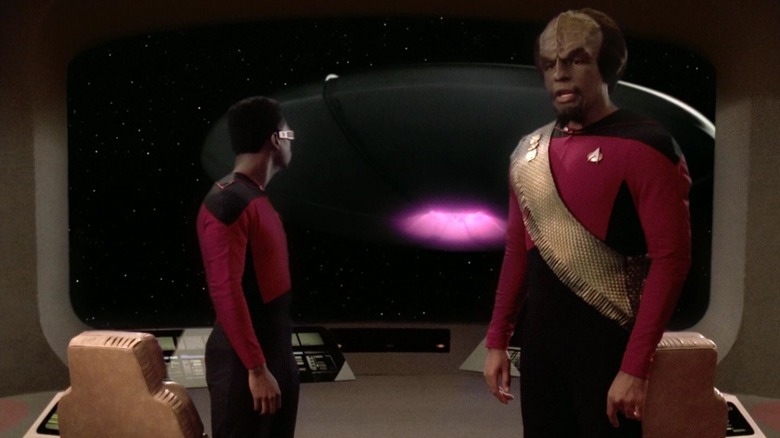Why Gene Roddenberry Put Michael Dorn's Worf On The Bridge In Star Trek: TNG
Way back in 1986, when Gene Roddenberry was still developing ideas for "Star Trek: The Next Generation," he gave himself and his collaborators a series of restrictive mandates. Most notorious of these was his infamous "no conflict" rule, demanding that none of the new show's stories revolve around interpersonal conflict between the main cast members. In Roddenberry's eyes, the future would be an idealized place where co-workers never bickered, and all problems were solved, without issue, as a group. This, as one can imagine, frustrated Roddenberry's writing team, who felt that the only way to generate drama was through interpersonal conflict.
Another mandate was Roddenberry's insistence that familiar "Star Trek" aliens be eschewed. "Next Generation" was to be a distinct entity, set nearly a century after the events of the original series, and Roddenberry wanted it to stand on its own. If it contained a Vulcan, Roddenberry knew that audiences would inevitably compare them to Spock (Leonard Nimoy). As such, he initially didn't want the Klingon Worf (Michael Dorn) to be part of the show, as audiences had already seen Klingons. Another one of the show's producers, Robert H. Justman, advocated for the inclusion of a "Klingon marine" on "Next Generation," feeling that his presence would be a dandy symbol that the Federation and the Klingons were now allies. Roddenberry liked that idea, and agreed to include Worf.
It's a good thing he did, as Michael Dorn's character has now become one of the franchise's most prolific, appearing on all seven seasons of "Next Generation," and on four seasons of "Star Trek: Deep Space Nine."
In 2013, Dorn spoke with the website Big Shiny Robot to talk about Worf, and he knew all about Roddenberry's reluctance to include the character. He also added the Roddenberry included Worf to stress the show's themes of pacifism.
Worf, while a tough character, was a symbol of peace
Dorn recalls the show creator having to field a lot of questions, mostly from the development team, about the Klingons. As anyone might tell you, the Klingons were one of the central antagonists of the original "Star Trek" series, and they had played roles in both "Star Trek: The Motion Picture" and "Star Trek III: The Search for Spock." When audiences last saw them, the Klingons were still villains, and the makers of "Next Generation" wanted to know if that detail would remain.
It wouldn't be until questions about the Klingons were answered that Roddenberry would even consider Dorn for the show. When Justman made his case, Roddenberry ran with the idea, turning the character into a symbol of pacifism. As Dorn noted:
"I was the last one cast. I was an afterthought. The story that backed that up is that people had given Gene so much guff about the Klingons, are the Klingons still the enemy, are the Klingons gonna be this and are they gonna be that? He just said, 'forget about this, we've moved on.' And that's why he put him on the bridge. That's one thing about Gene, is he's smart about television and those type of things, he wanted to show that people move on. It's not the same thing, it's not us against them."
"Star Trek," is, at its heart, a show about peace. War is anathema to Roddenberry's vision, and he did whatever he could to highlight a future without battles. If Worf could be a symbol of that pacifism, a symbol that Klingons were not only allies, but working on board the U.S.S. Enterprise — and in a central location on the bridge, no less — then Roddenberry would do it. And he did.
Sadly, Worf never got his spinoff.

